Americans have been using their imagination. And on April 5, 2025, they did something with it. They transformed the image into one of the largest public mobilizations in U.S. history.
It wasn’t just the size that mattered. The decentralized nature of the protests is what made them important, from liberal cities like mine, Washington, DC, to Maga strongholds like Madras, Oregon.
“What's most significant about today's day of action is the sheer number of locations where protests took place — more than 1000 towns and cities, all over the country. That's only happened one or two times before *in all of American history,*” L.A. Kauffman, a grassroots political organizer, activist and journalist who covers the history and impact of protest movements, wrote on the social media platform Bluesky. “The Black Lives Matter uprising of 2020 remains the largest protest mobilization in U.S. history by every measure.”
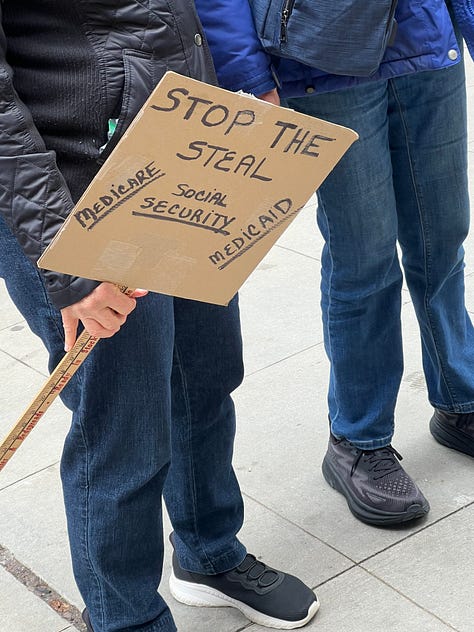
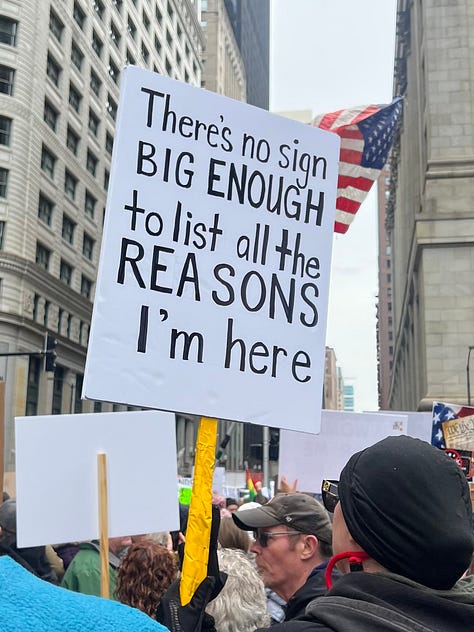
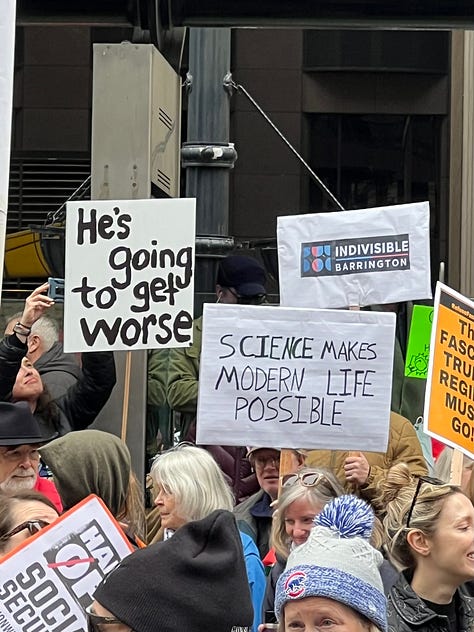
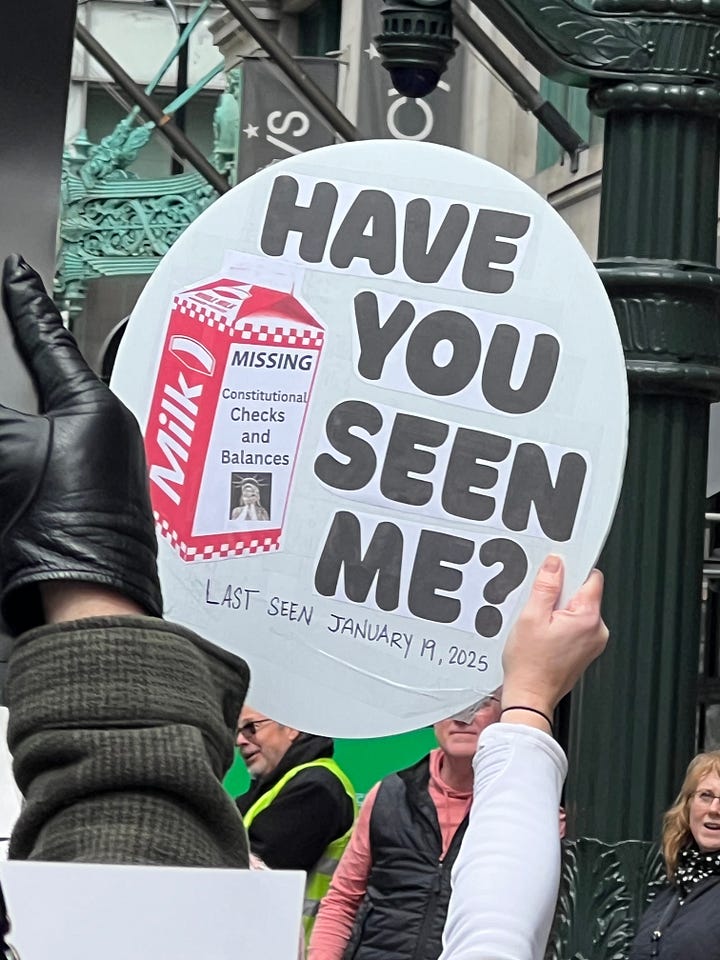
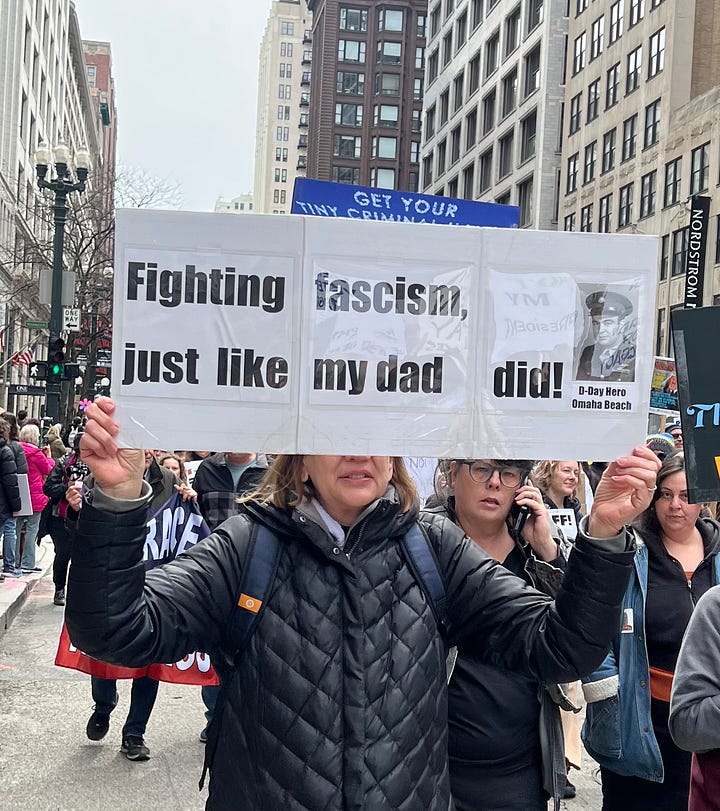
Whether the moment turns into a sustained and effective social and political movement rather than a performative act is up to Americans. But the day alone provides vital insight into what can support good mental health in times of crisis.
Invisible Threads reader Patty Zimmerman, who lives on an island in Casco Bay, Maine, told me the rally was a place to feel complex emotions in the presence of kindred spirits:
“Leaving on the Peaks Island ferry to Portland with a whole boatload of protesters carrying the signs made me proud of the organizing our community had been doing leading up to April 5th. The number of protesters on a cold, damp day in Monument Square was overwhelming. 90-year-old carrying canes and signs that read “Don’t take my SS away” saddened me. While a marching band played, our 15-year-old neighbor spoke about how bad she had been feeling and said the rally gave her hope for her future.” — Patty Zimmerman, Peaks Island, Maine
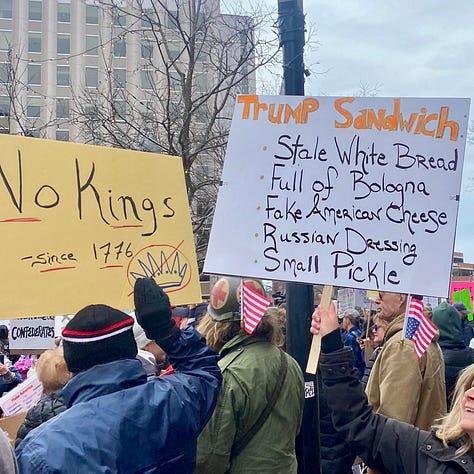
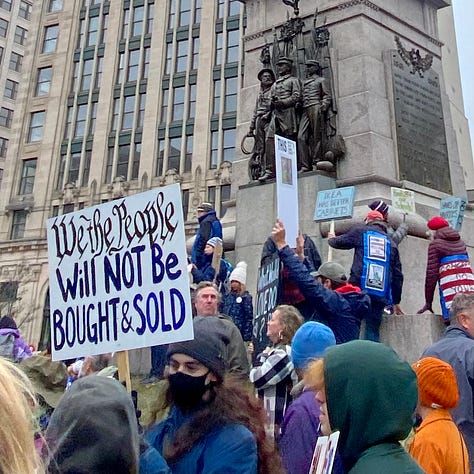
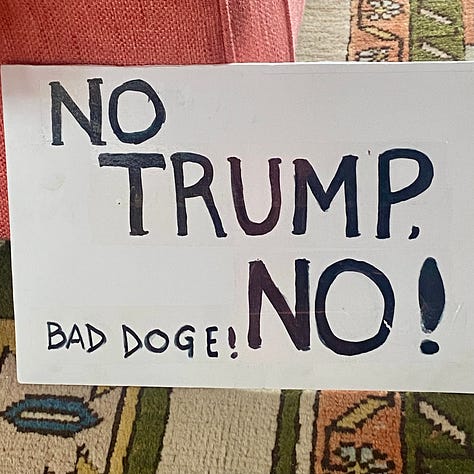
Before, during and after a protest, it’s important to pay attention to what we’re feeling and how our environment affects this, and then adjust to take care of ourselves. Why? Because, as I wrote in A journalist’s guide to staying grounded at protests: “When we’re frayed, so are our relationships.” It’s important to practice discerning what we need to feel grounded, “which makes trust and dialogue possible. In a democracy, that’s where everything begins.”
For millions of people who’ve felt overwhelmed and helpless about the rapid, seismic changes to the government, economy and society that America’s 47th president has overseen since Jan. 20, the April 5 protest was a much-needed way to regain agency and boost morale. Threats to one’s wellbeing can activate the “tend-and-befriend” stress response, which can boost oxytocin and reduce cortisol. So engaging in collective resistance like protests can reduce anxiety and nurture collective resilience.
At the same time, though, being in crowds or looking for connection with people who share empathy and care with some, but not all, can trigger negative stress. For that reason, not everyone’s resistance will look the same or take place all at once. And that’s okay. It’s important to find where, what and who feels supportive so we can honor ourselves while honoring others.
In D.C., the Hands Off protest attracted an older, predominantly White crowd, while a rally for an end to Israel’s war in Gaza was younger and more diverse. There were also rallies to end Russia’s war in Ukraine and to create an independent state for Sikhs in India. Smaller towns won’t have this menu of protest options, but there are often library talks and online happenings that provide ways people can connect with others and give and receive support. This goes for liberals, conservatives and political agnostics. Finding what makes sense for you is what’s important.
Dr. Rhonda Hamilton, a DC mayoral candidate, mental health advocate and founder and executive director of M.I. Mother’s Keeper, told me some members of her Black community feel like they’ve already played their role in fighting to make America better, and now it’s someone else’s turn. She said she understands this but feels it’s no time for anyone to sit out.
(DC native Dr. Rhonda Hamilton discusses the trauma of her community and the country.)
Rhonda questioned the mental health of the president, saying the cruelty of his actions, including attempting to erase Black history, suggests he may not be in “his right mind.”
While many Americans think President Trump is doing a good job, including 98 percent of Republicans in my home state of Maine, the chaos he’s sowed has caused widespread fear for others. Fear is contagious, but calm can be too. Joe Feldman, founder of CoverMyMentalHealth.org, told me he noticed this shift on his way to the Hands Off rally in Chicago’s Daley Plaza Saturday:
“The positive energy started at the commuter train station before heading into the city and it never subsided. Much confidence, togetherness, community. No anger, no sense of violence, no hate. Even the Chicago Police were smiling on the sidelines. No provocation of riot gear. It felt like going to a sporting event where we were all rooting together for the home team. That hometown crowd feeling was reassuring. Not alone. Reason to be hopeful. And yet the season is far from over.” — Joe Feldman, CoverMyMentalHealth.org
Regardless of identity and political persuasion, there is growing agreement that America is not entirely well. If we want communities and systems to support collective wellbeing, we can’t recreate what we’ve done before. It’s time for each of us to reflect on our values and consider what we can do differently to bridge the gulf between where we are and where we want to be. This doesn’t have to be big to start. If, for example, you don’t like the violence and division of a particular party or group, notice whether you’re using violence and division in your own language and beliefs. If you winced at the division that “Fuck Biden” signs inspired, are you okay with the “Fuck Trump” slogan? If you think you support everyone’s humanity and dignity, then try joining another group’s rally or examine the roots of what they’re calling for.
Change happens fast, but transformation takes time. And generally, the greatest transformation has to happen within ourselves.
Hi, I’m Kate, and I’m so glad you’re here…
After more than two decades reporting on democracy, trauma and repair from Cuba to Cambodia, and leading news teams through global upheaval at the Voice of America, Al Jazeera English and The Washington Post, I hit a breaking point on January 6, 2021. I was swarmed by the mob at the U.S. Capitol and defused the threat with humor and humanity. My Post colleagues and I won the Pulitzer Prize for Public Service, a professional pinnacle, and I gained something more: complex PTSD and a deep understanding of how broken systems impact our bodies, minds and civic fabric.
I realized that staying inside a compromised system meant suffering trauma, burnout and moral injury to keep telling stories about everyone else’s. In Jan. 2024, I left daily journalism to build something new.
I founded Invisible Threads, a media, education and action lab to trace what connects our inner lives to our shared world — and to remind us that healing isn’t soft, it’s strategic. Now, as a scholar at Georgetown and co-developer of a new framework for systems change, I work with individuals, communities and institutions to break inherited patterns of harm and build something sturdier: collective resilience. It’s not easy work. But it’s the kind that leaves a mark, the kind that remakes you as it remakes the world. I chose this path because I couldn’t not. And maybe, if you’ve read this far, you know that feeling, too.
Step by step together,
Kate

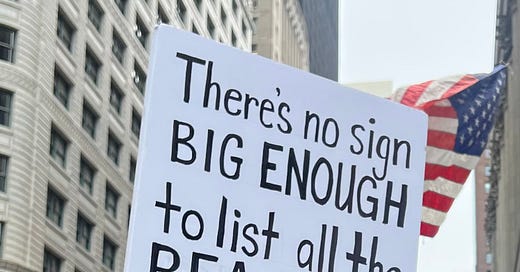






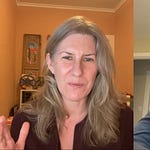
Share this post